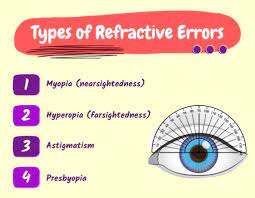
A refractive error is a very common eye condition where the shape of your eye prevents light from focusing correctly on the retina, resulting in blurred vision. Essentially, the eye’s refractive power (its ability to bend light) doesn’t match the length of the eyeball, causing images to be focused either in front of or behind the retina, instead of directly on it.
This condition is the leading cause of vision impairment globally, affecting both children and adults.
Here are the main types of refractive errors:
- Myopia (Nearsightedness/Short-sightedness): Distant objects appear blurry, while close objects are clear. This usually happens when the eyeball is too long or the cornea (the clear front surface of the eye) is too steeply curved, causing light to focus in front of the retina.
- Hyperopia (Farsightedness/Long-sightedness): Nearby objects appear blurry, while distant objects may be clearer (especially in mild cases or in younger individuals who can compensate). This occurs when the eyeball is too short or the cornea is too flat, causing light to focus behind the retina.
- Astigmatism: Vision is distorted or blurry at all distances. This is due to an irregular curvature of the cornea or lens, which causes light rays to focus at multiple points instead of a single, sharp point on the retina. It’s often described as seeing things through a wavy mirror.
- Presbyopia: This is an age-related condition that typically develops after age 40. It makes it difficult to focus on close objects because the natural lens inside the eye becomes less flexible and loses its ability to change shape to focus light properly.
Causes of Refractive Errors:
Refractive errors can be caused by:
- Eyeball length: The eyeball being too long (myopia) or too short (hyperopia).
- Corneal shape: An abnormally steep, flat, or irregularly curved cornea (astigmatism, myopia, hyperopia).
- Lens issues: A thicker or thinner lens than normal, or the natural hardening and loss of flexibility of the lens with age (presbyopia).
- Genetics: A family history of refractive errors increases the risk.
Symptoms of Refractive Errors:
The most common symptom is blurred vision at one or more distances. Other symptoms can include:
- Double vision
- Hazy vision
- Seeing a glare or halo around bright lights
- Squinting
- Headaches
- Eyestrain
- Difficulty focusing when reading or using a computer
Correction and Treatment:
Refractive errors can be diagnosed during a comprehensive eye exam and are typically corrected with:
- Eyeglasses: The simplest and safest method.
- Contact Lenses: Worn directly on the surface of the eye.
- Refractive Surgery: Procedures like LASIK or PRK can permanently change the shape of the cornea to correct the refractive error.
